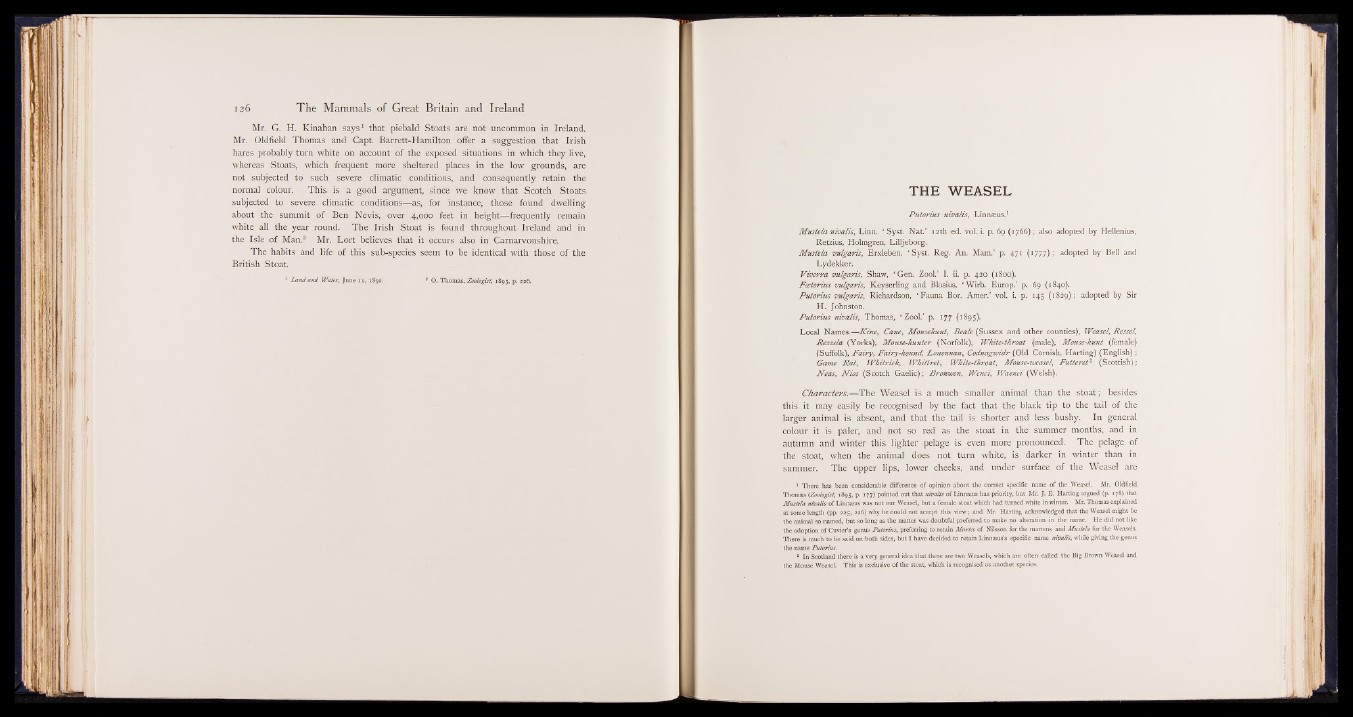
Mr. G. H. Kinahan says1 that piebald Stoats are not uncommon in Ireland.
Mr. Oldfield Thomas and Capt. Barrett-Hamilton offer a suggestion that Irish
hares probably turn white on account of the exposed situations in which they live,
whereas Stoats, which frequent more sheltered places in the low grounds, are
not subjected to such severe climatic conditions, and consequently retain the
normal colour. This is a good argument, since we know that Scotch Stoats
subjected to severe climatic conditions—as, for instance, those found dwelling
about the summit of Ben Nevis, over 4,000 feet in height—frequently remain
white all the year round. The Irish Stoat is found throughout Ireland and in
the Isle of Man.2 Mr. Lort believes that it occurs also in Carnarvonshire.
The habits and life of this sub-species seem to be identical with those of the
British Stoat.
1 Land and Water, June n , 1892. 2 O. Thomas, Zoologist', 1895, p. 226.
THE WEASEL
Putorius nivalis, Linnaeus.1
Muslela nivalis, Linn. ‘ Syst. Nat.’ 12th ed. vol. i. p. 69 (1766); also adopted by Hellenius,
Retzius, Holmgren, Lilljeborg.
Mustela vulgaris, Erxleben, ‘ Syst. Reg. An. Mam.’ p. 471 (1777); adopted by Bell and
Lydekker.
Viverra vulgaris, Shaw, ‘ Gen. Zool.’ I. ii. p. 420 (1800).
Fcetorius vulgaris, Keyserling and Blasius, ‘Wirb. Europ.’ p. 69 (1840).
Putorius vulgaris, Richardson, ‘ Fauna Bor. Amer.’ vol. i. p. 145 (1829); adopted by Sir
H. Johnston.
Putorius nivalis, Thomas, ‘ Zool.’ p. 177 (1895).
Local Names.—Kine, Cane, Mousehunt, Beale (Sussex and other counties), Weasel, Ressel,
Rezzela (Yorks), Mouse-hunter (Norfolk), White-throat (male), Mouse-hunt (female)
(Suffolk), Fairy, Fairy-hound, Lonennan, Codnagwidr (Old Cornish, Harting) (English);
Game Rat, Whitrick, Wkittret, White-throat, Mouse-weasel, Futteret2 (Scottish);
Neas, Nios (Scotch Gaelic); Bronwen, Wenci, Waenci (Welsh).
Characters.—The Weasel is a much smaller animal than the stoat; besides
this it may easily be recognised by the fact that the black tip to the tail of the
larger animal is. absent, and that the tail is shorter and less bushy. In general
colour it is paler, and not so red as the stoat in the summer months, and in
autumn and winter this lighter pelage is even more pronounced. The pelage of
the stoat, when the animal does not turn white, is darker in winter than in
summer. The upper lips, lower cheeks, and under surface of the Weasel are
1 There has been considerable difference of opinion about the correct specific name of the Weasel. Mr. Oldfield
Thomas (Zoologist, 1895, p. 177) pointed out that nivalis of Linnaeus has priority, but Mr. J. E. Harting argued (p. 178) that
Mustela nivalis of Linnaeus was not our Weasel, but a female stoat which had turned white in winter. Mr. Thomas explained
at some length (pp. 225, 226) why he could not accept this view; and Mr. Harting acknowledged that the Weasel might be
the animal so named, but so long as the matter was doubtful preferred to make no alteration in the name. He did not like
the adoption of Cuvier’s genus Putorius, preferring to retain Martes of Nilsson for the martens and Mustela for the Weasels.
There is much to be said on both sides, but I have decided to retain Linnaeus's specific name nivalis, while giving the genus
the name Putorius.
2 In Scotland there is a very general idea that there are two Weasels, which are often called the Big Brown Weasel and
the Mouse Weasel. This is exclusive of the stoat, which is recognised as another species.